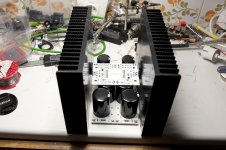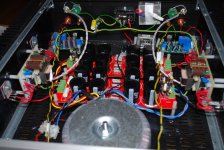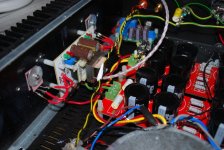Too bad your not in NC anymore, you could listen to a whole range of FW clones. I could give subjective opinions, with measurements, but who would listen.
If you are suggesting that it would be interesting to see if certain measurements of amp function could be always related to specific sound perception I would have to agree most strongly. So I for one would listen to your views. Hard work though.
Reviews in magazines are usually centred on a particular model without trying to break down why those sounds are the way they are. Nelson seems to know how a particular circuit will sound but then he builds them so often he knows how to join the dots.
A question relating to how the F6 sounds when you are playing with the pots/phase thing: Is it possible in any amp to get maximum sense of space and depth in the soundstage whilst at the same time enjoying pinpoint accuracy of instrument position or do we always have to sacrifice one for the other?
It occurs to me that electrons have the same problem: momentum or position but not both at the same time.
If you are suggesting that it would be interesting to see if certain measurements of amp function could be always related to specific sound perception I would have to agree most strongly. So I for one would listen to your views. Hard work though.
Reviews in magazines are usually centred on a particular model without trying to break down why those sounds are the way they are. Nelson seems to know how a particular circuit will sound but then he builds them so often he knows how to join the dots.
A question relating to how the F6 sounds when you are playing with the pots/phase thing: Is it possible in any amp to get maximum sense of space and depth in the soundstage whilst at the same time enjoying pinpoint accuracy of instrument position or do we always have to sacrifice one for the other?
It occurs to me that electrons have the same problem: momentum or position but not both at the same time.
Maybe Heisenberg had a F6
Last edited:
I am using a 3u 300mm deep sink per channel on my f6 build and use the same size on my moskido biased at about 1.2A per device.
I have one channel of the f6 running and biased at 1A per device. Let it sit for about 30 min and it was very warm but I could keep my hand on it. I will take a temp reading today.
Also I have a 4device per channel f5 and use the 4u 300mm deep sinks on it. Bias is set at about .5A per device and the sinks work well.
200mm on the 4u would be pushing it and you would probably struggle to reach 1A per device.
I have one channel of the f6 running and biased at 1A per device. Let it sit for about 30 min and it was very warm but I could keep my hand on it. I will take a temp reading today.
Also I have a 4device per channel f5 and use the 4u 300mm deep sinks on it. Bias is set at about .5A per device and the sinks work well.
200mm on the 4u would be pushing it and you would probably struggle to reach 1A per device.
I guess the biggest issue is still the environment that the caps live in... We need to make sure they will live long and prosper...
Here is a first attempt of what I will try to build.
The transformer and the rectifier will be on a separate chassis to minimize vibration and e/m interference.
The rest of the chassis will be made out of wood and I will probably add a small separately powered fan on the back to allow good ventilation in the small box.

Here is a first attempt of what I will try to build.
The transformer and the rectifier will be on a separate chassis to minimize vibration and e/m interference.
The rest of the chassis will be made out of wood and I will probably add a small separately powered fan on the back to allow good ventilation in the small box.
Attachments
You putting both channels in there? Seems like too much sink for one Fet, although you can never have too much sink. You will definitely have option of more bias. In truth. Having more space around caps and getting them away from sinks would help, but if you ventilate well, it should not be an issue. They have 85C rating and only improve lifespan below that.
You putting both channels in there? Seems like too much sink for one Fet, although you can never have too much sink. You will definitely have option of more bias.
No just 1 channel in there. The sink is the one I mentioned above, so 1 for each fet with some headroom for additional bias or cooler operation.
It works
So I recently took delivery of some F6 PCBs from Tea-Bag. Firstly I must say that these are really fabulous boards!
They got stuffed the night that I got them and after a small break from building on Valentines I managed to get them up and running in my old F5/F2J case.
I have a touch of hum, but mainly because of the layout. The CRC boards are very close to the F6 boards which isn't ideal. The CRC boards are from my (long time dismantled) F5. I am going to change the PSU to something more compact so that I can separate the transformer and CRC boards from the F6 boards with some thick aluminium sheet with MuMetal shielding.
I also need to flip the heat sinks over in the case. The JFETs are mounted quite high on the heat sink. The tops of the sinks get pretty hot, while the bottom is only slightly warm. Hopefully flipping them will help dissipate the heat a bit better.
I am running conservative at 1.2A and have 0.05R source resistance in the bottom JFET.
The only problem that I have at the moment is a bit of channel imbalance, I think this is because I have 2 very well run in JFETs (pulled from the F2J) in one channel and 2 JFETs with only a few hours in the the other channel. Worst comes to the worst I can compensate for this.
So how does it sound - apart from the little bit of hum - fabulous. My F2J was warm and rich, maybe a bit too warm. The F6 is a little less voluptuous but (for now) my favourite so far....
I have attached a couple of pics, you can see how close the rectifiers are to the Cinemag xformers. This will be resolved!
So I recently took delivery of some F6 PCBs from Tea-Bag. Firstly I must say that these are really fabulous boards!
They got stuffed the night that I got them and after a small break from building on Valentines I managed to get them up and running in my old F5/F2J case.
I have a touch of hum, but mainly because of the layout. The CRC boards are very close to the F6 boards which isn't ideal. The CRC boards are from my (long time dismantled) F5. I am going to change the PSU to something more compact so that I can separate the transformer and CRC boards from the F6 boards with some thick aluminium sheet with MuMetal shielding.
I also need to flip the heat sinks over in the case. The JFETs are mounted quite high on the heat sink. The tops of the sinks get pretty hot, while the bottom is only slightly warm. Hopefully flipping them will help dissipate the heat a bit better.
I am running conservative at 1.2A and have 0.05R source resistance in the bottom JFET.
The only problem that I have at the moment is a bit of channel imbalance, I think this is because I have 2 very well run in JFETs (pulled from the F2J) in one channel and 2 JFETs with only a few hours in the the other channel. Worst comes to the worst I can compensate for this.
So how does it sound - apart from the little bit of hum - fabulous. My F2J was warm and rich, maybe a bit too warm. The F6 is a little less voluptuous but (for now) my favourite so far....
I have attached a couple of pics, you can see how close the rectifiers are to the Cinemag xformers. This will be resolved!
Attachments
Last edited:
A question relating to how the F6 sounds when
you are playing with the pots/phase thing: Is it possible in any amp to get
maximum sense of space and depth in the soundstage whilst at the same
time enjoying pinpoint accuracy of instrument position or do we always have
to sacrifice one for the other?
I think it depends one what you mean by "space and depth" on the one hand
and "pinpoint accuracy" on the other. At the very best, I have seen lots of
space and depth and also have been able to drill down to the particulars of
a given instrument in a group and focus on it, somewhat to the exclusion of
the others.
It takes a lot of things working right to get that, but I am not sure that
it represents "pinpoint accuracy"
- Home
- Amplifiers
- Pass Labs
- F6 Amplifier


